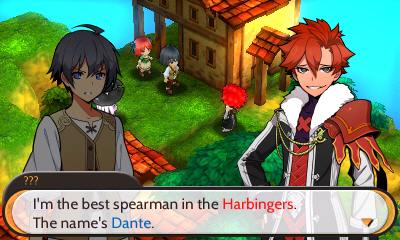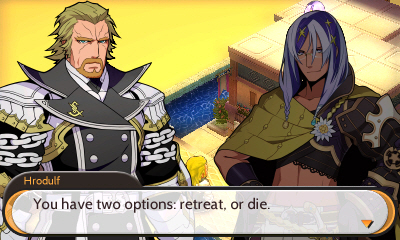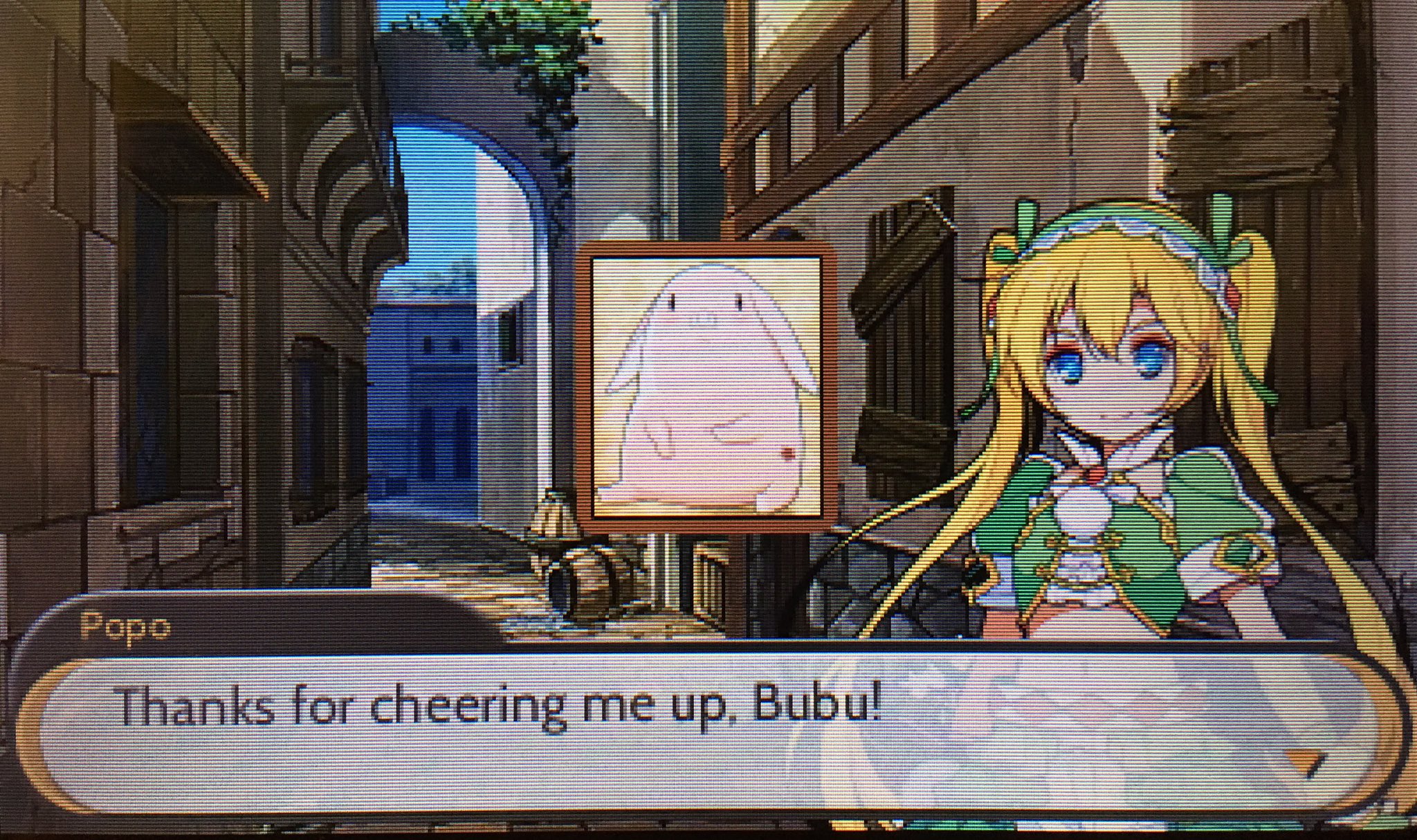The backstory to Stella Glow’s world is exposited in its
opening scene. A nondescript god stole
the ability to sing from humanity and attempted to destroy humanity with an
army of angels. As Shin Megami Tensei,
Xenoblade and Mortal Kombat have shown us, god’s a jerk. A fabled hero named Elcrest used something
called the conductor’s power to utilize five witches and their magic singing in
order to defeat god. Witches are the
only ones capable of singing and using magic thanks to five magic jewels called
Qualia, one for each of the four basic elements and one for time.
Thousands of years later, you play as Alto, a young teen
amnesiac found in a lake who discovers he has the power of the conductor and
his friend Lisette inherits the water qualia to become the water witch. Both find themselves joining the royal
knights of the local kingdom
of Regnant
 |
| His spear is named Vergil. |
In order to reverse the crystallization, the knights travel
to the corners of the earth to find the other three witches so the four can
perform a stupendous quartet song called The Anthem. Sadly, tragically, it doesn’t sound a thing
like Good Charlotte. Every step of the
way the Harbingers try to get to the witches first and kill them so the anthem
can’t be performed.
Gee, an epic RPG where you gotta collect four treasures of
the elements. I’ve never heard THAT one
before.
They’re inside people in this case, but the overall concept
stands.
I won’t go very far into the plot’s intrigue because, to be
honest, Stella Glow’s plot is one of the most by the numbers, predictable and cliché-heavy I have played in a long time. With the exception of a few aspects of a
certain major plot turning point, every single thing that happens has been done
before many times in other JRPGs and Japanese media with very little to mix up
the scenario. Even within its own story,
gathering the witches follows a bit of a formula, making it feel as though
you’re doing the same story over and over again. As a story for the seasoned gamer, players
might be disappointed with Stella Glow, but what it lacks in plot it makes up
for in the characters.
As the knights travel the world they meet a lot of different
characters to add to their party. You’d
be forgiven for thinking that the characters are just as generic as the plot at
a glance as they all seem specifically designed to appeal to certain kinds of
people. There are cutesy young girls ranging from clumsy, motherly, childish
and eccentric while the guys have bishies
ranging from haughty, smug, smart and one is a huggable sensitive giant. Rest assured, there are actual characters
behind each of them and they aren’t as samey as the plot is.
For such a large party of traveling companions it’s admirable
that the game is able to give them all an equal amount of attention in the
story and have them all compliment each other by acting as foils and
support. Each one has their own
personalities, character flaws, hidden depths and motivations, but to see most
of that you’ll have to spend time with them.
Much like games with relationships values like the Persona games
post-Persona 2, you’re given free time in between missions to spend time with
members of your party. You can also use
up the time to explore for items or do part time jobs for cash, but you’ll have
such an abundance of those things before long that it’s far more important to
spend time with others.
Spending time with a squadmate gives them new abilities and
moves to use in battle, which is the best thing you can have to get some real
money and items anyway. This is doubly
true for the witches, whom you’ll definitely want to spend time with because
they can use songs, which are abilities in a class of their own.
The free time events are where Stella Glow shines
brightest. They can be heartwarming,
funny, adorable, dramatic and everything in between. They all help establish a better connection
with the people you fight with, which I always appreciate.
There’s only one character in Stella Glow I consider a bad
character and it is unfortunately a pretty important one: Alto, the main
character. Other characters can hold my
interest, but when the main character is the worst character it undermines the
whole story. Alto isn’t bad
moralistically. In fact, it’s quite the
opposite. Alto is a part of the plot,
and as I said, the plot is generic, so to fit into that, Alto is incredibly
boring. He is a nice goody-two-shoes
Kirito-style Marty Stu who doesn’t have any real struggle in the story, doesn’t
seem to have any hobbies or interests and can get on the good side of every witch,
which kind of gives off a sexist alpha male vibe if you ask me, but the game
doesn’t push it. There is next to
nothing to him other than being the hero.
There’s a point in the story you might expect him to change a little,
but he never does. He’s bland through
and through.
It’s not like a goody two-shoes character has to be boring. Asuka in
Senran Kagura is a great example, as she has her own moral philosophies she has
to think about and has to learn about others in order to understand people to
make friends with them. Alto has a
little bit of the learning part with certain characters in their free time
events, but it’s never developed enough, especially since you can run out of
free time before you finish them.
Like a lot of Atlus games, characters are enhanced by
the voice acting. Stella Glow has a lot
of the usual recognizable voice actors like Matt Mercer, Melissa Fahn, Kyle
Hebert and Keith honkin' Silverstein, for a start. Lesser known is
Alto’s voice actor, Robbie Daymond, who does a good job with what he’s given,
but not even the best voice actors in the world could make Alto any less
boring.
My favorite actresses in particular are Christie Cabanos,
Cindy Robinson and Christina Vee.
Cabanos gives Lisette a sweet purehearted charm, Robinson is great
at more firey and mature characters and Vee makes the shy, devoted, cardboard
box-wearing go-getting ninja absolutely hilarious and adorable.
But let's be real. The best character is Popo's badass war hog Bubu, who, like Senran Kagura's Bebe-tan, is so good he doesn't even fight because that would make things too easy.
The characters are enough to give Stella Glow its own identity within the derivative plot, but if you were expecting some mix-ups in the gameplay department, think again. The gameplay is pretty much like any other tactical RPG. You take turns based on character stats, use skills and items, get experience, have advantages when attacking from the sides or behind and equip everyone for better stats and effects. If you’ve played a game like Final Fantasy Tactics or the developer’s previous Luminous Arc games, you know what to expect here. I don’t think that’s inherently a bad thing because it means the experienced gamers this is targeted to can jump right in without having to learn much of any new rules or mechanics.
The characters are enough to give Stella Glow its own identity within the derivative plot, but if you were expecting some mix-ups in the gameplay department, think again. The gameplay is pretty much like any other tactical RPG. You take turns based on character stats, use skills and items, get experience, have advantages when attacking from the sides or behind and equip everyone for better stats and effects. If you’ve played a game like Final Fantasy Tactics or the developer’s previous Luminous Arc games, you know what to expect here. I don’t think that’s inherently a bad thing because it means the experienced gamers this is targeted to can jump right in without having to learn much of any new rules or mechanics.
The differences Stella Glow has from other games of its kind
lie in its presentation quirks and the songs alongside that. The entire party shares a song gauge
represented by Alto’s Song Stone, essentially a magic conductor’s wand. The witches can use that power to sing their
songs in battle. We don’t get to hear
the likes of Cindy Robinson or Stephanie Sheh sing, although I’m sure they
can. The game uses the Japanese voices for
the singing.
A witch’s song has to be unlocked from their heart through a
process Alto can perform called tuning. As
part of tuning, Alto (and the party) go into the witch’s heart
Psychonauts-style and have a battle with shadow visages to resolve the parts of
their hearts that are holding them back, like fear and bad memories. These mindscapes aren’t even on the same
level of Psychonauts though, as they all use the same terrain and overall
structure for much less visual variety, a recurring issue in the game.
There are two kinds of songs each witch can use. The quickest to use are small medleys that only
take up one or two stocks of the song stone and have an effect over a wide
area, including buffs, debuffs, damage and healing.
The much more powerful ones are the conductor songs, which
use up four stocks. For that, Alto has
to stab the song stone into the qualia in the witch’s chest to initiate a
proper song with instrumental accompaniment.
These songs cover the entire field, override the background music, the
witch sings it continuously for a few turns and each time it’s their turn while
they’re singing, they add another effect.
As intended, they are great boons of power that can turn the tables in a
tight spot and all of them sound grandiose to further emphasize that
power. The songs themselves are varying
styles of J-pop music reflecting the witch’s personality. The only disappointment is that in order to
get a second conductor song for a witch, you have to max out your relationship
with her, which as mentioned earlier, may not happen and it’s even less likely
you’ll get all of them on one playthrough.
You can get them all on the game’s New Game Plus that triples the free
time you get, but by that point you’ll probably be done with the game for a
while.
The song mechanic is very competently executed from an
aesthetic standpoint. That the witches
are the only ones that can sing while the rest of the world is deprived of it
makes the color and vibrancy they give off have more of an impact. It has the power of song without being a
musical. With that said, I would not
recommend the soundtrack as a whole anytime soon. Like many games these days, pre-orders for
Stella glow came with the soundtrack, but only with the witch’s songs because they are the only part
of the game's music that stands out. Everything else is,
like Alto and the plot, generic and forgettable. Not poorly made or distracting, just plain, and I don't think that was an intentional design choice to try to make the witch songs comparatively better.
The other presentation quirk Stella Glow has is its fighting
animations. When using skills (including
songs), action cuts to the chibi versions of the characters performing them,
much like Fire Emblem. Not only are the
chibis just plain cute, but the detailed movements, expressions, camera
angles and snappy voice acting add to their charm and sense of impact.
Some of my favorite moves include Hip Drop, where Lisette
accidentally sends herself flying upward and lands hip first on the enemy, and Beesting,
where Nonoka trips, bounces on her cardboard helmet and accidentally stabs the
enemy before falling over. Just about
all of fire witch Sakuya’s moves are great too.
Also like Fire Emblem, the animations can be turned off on
the fly, which is good because there is a lot of dreadful repetition. Settings change, but overall structure does
not. Beating down enemies to get from
point A to point B to beat down more enemies is the name of the game here and
Stella Glow gets its challenge from swarming you with weak enemies and the
occasional more powerful enemy. That can
be a legitimate challenge, having to maneuver around enemies, activate songs at
the opportune time and equip everyone with the right items for the situation,
but there isn’t much variety outside of that.
You can count the number of unique enemies on two hands because most of
them are palette swaps for a different element or different strength level,
essentially meaning you’re fighting the same enemies over and over for the
entire game. Boss characters change
things up a good bit, but they can only offset the repetition so much.
Making matters worse is the length of these missions badly
damages the story’s sense of pacing.
Missions can take over an hour even if you skip the animations and gets
even worse when a mission enters a second phase and swarms the map with even
more enemies. Couple that with the
limited enemy variety and you have a monotonous journey ahead. There was some fat that needed to be cut
here. This game does not feel like it
needed to be over 50 hours long. When
I’m exclaiming “finally” instead of “victory!” something has gone wrong. That goes double for a point in the story
where you have to arbitrarily revisit past areas before the plot goes anywhere.
A lot of the game overall feels lacking in polish. It’s
standard for a visual novel-style game to use static character portraits with
nothing but the expressions changing and the occasional artwork, but Stella
Glow’s presentation of its dialogues outside of battle only goes for that minimum and doesn’t do
much beyond that. I wouldn’t mind
normally, but story sequences in between missions are so long it gets boring to
look at and the dialogue often feels like it needs some enforcement of the
“show, don’t tell” rule.
If you look at Blazblue or Senran Kagura, they have little
visual effects for more outward expressions and actions that can contribute a
lot to giving those static images a sense of movement. Not even the 3D effect is used for anything more but making the HUD pop out. Stella Glow gives me the impression that the
only thing it benefited from the 3DS over the original Nintendo DS was the
voice acting and battle animations.
 |
| I'd sure retreat if Kirk Thornton threatened me. |
At the end of the day, Stella Glow is pretty much your
average strategy RPG that doesn’t strive to be much of anything more. All its pieces are competently done, but
apart from the characters and singing concept, little about it stands
out, but that might be enough for some
gamers. Stella Glow isn’t as
polished as other games in the genre, but it will
probably appeal to certain players in a “X, but with Y” sort of way. In the same way I like Sleeping Dogs because
it’s Grand Theft Auto, but with kung fu fighting, I know people who
would like that Stella Glow is a tactical RPG, but with a cute moe squad (of
both guys and girls) and a musical spin on things. If you think you
might be one of those people, Stella Glow is worth a try. If not, there are games like it I'd recommend sooner. I give Stella Glow a 6.5 out of 10.






No comments:
Post a Comment